Sink from porcelain tile. advantages and disadvantages.
It is difficult to say that in the kitchen too much or without what you can do, but without washing you just can not get along. Any cooking, washing dishes, etc. The desire to somehow highlight such a useful thing is understandable, engineers and designers have worked well in this direction. The result of creativity - washing of porcelain tiles for the kitchen.
Let's get acquainted with the invention closer.
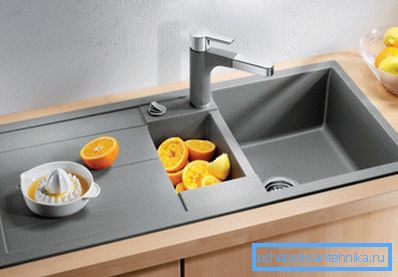
Random invention
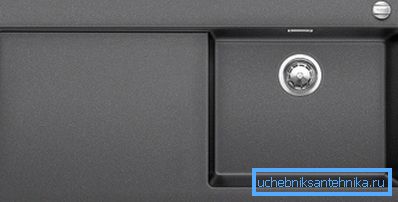
Initially, porcelain tile was far from both sinks and kitchens. The material arose under a very specific order, it became necessary to develop a beautiful, heavy-duty floor covering for production workshops and places of mass visits.
The result was a pressed mixture of various clays, sand, and pigment powders, which was then roasted as a common pottery. Due to the initial plasticity of the composition, the mixture can take almost any shape, and coloring oxides give the product a uniform monochromatic color.
Positive points

Standard enameled sinks or stainless steel counterparts have their advantages and disadvantages, but the drumming of falling water is not very pleasant to hear. In addition, the above mentioned bowls have very limited color solutions, which in our time greatly reduces their attractiveness.
Ceramic granite sinks for the kitchen are free from the drawbacks and limitations of their relatives and attract customers with the following characteristics:
- The material is durable, perfectly withstands heavy loads, even with a margin of safety;
- Due to the homogeneity of the structure obtained by thermal means, the material indifferently perceives aggressive media.. Acids and alkalis, used in everyday life, he is not afraid;
- For the same reason, porcelain tile is calm to a sharp change in temperature. - cold, hot water, boiling water or ice - do not harm him;
- The absence of the composition of the product of artificial ingredients and dyes, automatically transfers them to the category - environmentally friendly;
- These sinks have a wide range of colors., which already makes them more attractive to potential buyers. Taking into account the possibilities of the forms of the sink itself, individual bowls, such products can decorate not only standard fonts in the kitchen, but also designed for individual requests;
- Intense in choosing care products. For washing, you can use any means of chemistry available at a price.
Characteristic cons of the material
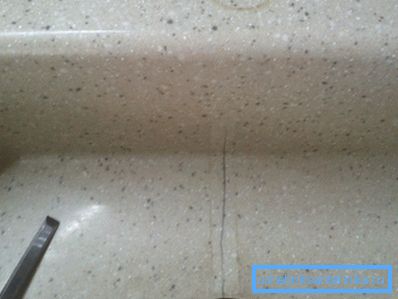
Sink with porcelain stoneware for the whole variety of positives has a number of drawbacks, which, although not fatal, bring about their own changes.
These include:
- Such products are not subject to repair. Although the bowls themselves are very strong, it is practically impossible to break them without intent, but everything happens in life, but chips are not glued and polished. Like ceramics, a damaged product can only be replaced with a new one;
- This drawback can hardly be called such; rather, it looks like a test for lazy housewives. It is believed that the porcelain stoneware kitchen sink should be cleaned more often than usual. No further comments;
- The price of the product, of course, is incomparable with the metal, it will be higher, and made to order, with several different deep bowls or irregular shapes - much higher.
Principles of installation
Characteristics are understandable, and the practical component is no less important.
Installation of such products is of two types:
- Overlay or tie-in;
- Integration.
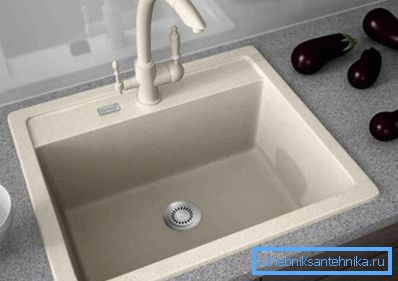
Note! As the installation of the bowl called overhead or mortise and integrated.
Surface mounting option
The first type of installation is considered the simplest, does not require the skills of a master or equipment. The process itself is carried out by hand without advisers and specialists.
You need:
- In the worktop to outline the contours of the future holes for the internal size of the bowl;
- Electric fretsaw for MDF, grinder with a circle (diamond-coated) for the stone to make a window in the tabletop;
- Install a sink on a pad of sealant under the outer edge of the product in order to limit the ingress of grease and dirt into the space between the bowl and the table top;
- Installation of plumbing equipment is carried out as standard, given that the holes for them are made of specified sizes.
Practical observation! Do not be afraid to remove the extra millimeters of the tabletop, the outer edge of the sink will hide this minor defect.
This is a simple instruction, but there is more complicated.
Countertop Integration
The complexity of this method was initially determined by the purpose of the installation. The technique implies a clear placement of the product in the tabletop.
In this case, the bowl itself is located either:
- flush;
- below the countertop level.
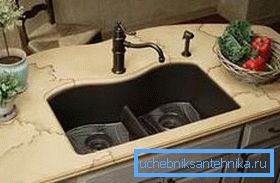
For information! There is another method of integrating the placement of the sink - slightly above the level of the tabletop. In this technique, the bowl does not fit on top of the tabletop, but is inserted into the prepared window just above the level of the canvas. For integration placement, a machine is needed for accurate cutting and preparing the bed for washing.
Tip! Placement of the sink on a stone worktop using the integration method can be at any level flush, lower or higher. When placing the sink on the MDF worktop, the method below the worktop level will not work, for aesthetic and practical reasons.

Caring for washing
Proper care can be divided into the following areas:
- Daily care. There is hardly any need to say that washing the dishes is necessary to finish washing the sink and removing food waste. Cleaning the product ends with rinsing the sink from soap stains and traces of cleaning powders;
- Removal of plaque. This option of care is possible with the formation of limescale. Usually ordinary table vinegar copes well with it, but it copes well with unpleasant odors. For serious formations, you can use any chemical compounds from the set of household chemicals in the supermarket.
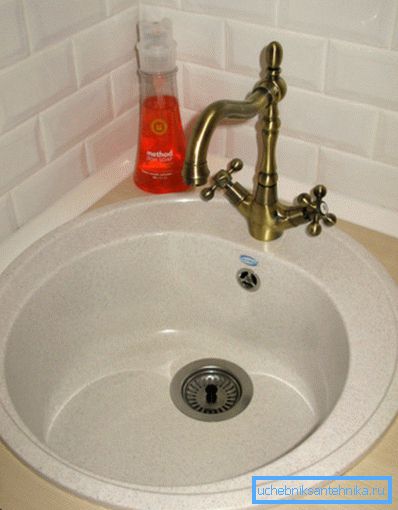
Tip! Although the coating of porcelain stoneware is strong enough, rubbing it with metal mesh is not recommended. Grid it does not hurt, but microcracks and micro-scratches will be excellent "handrails" for lime and microorganisms accumulation. But then read the second paragraph in the section on deficiencies.
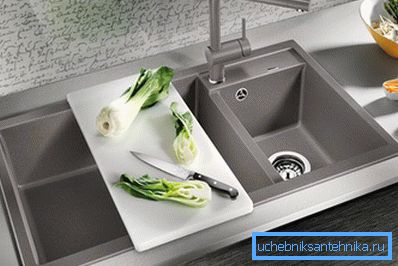
Finally
The choice of a practical product is a difficult step, many are discouraged by the price of porcelain stoneware, some of the complexity of installation. Product breakage is not excluded, and then there will be a need to order a new car wash, but for ready-made dimensions, and this is an individual order.
Given all the characteristics, these products are able to give your kitchen personality traits. And the video in this article is ready to share its thematic selection of information.